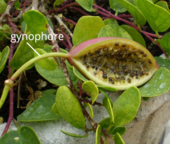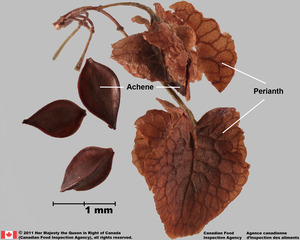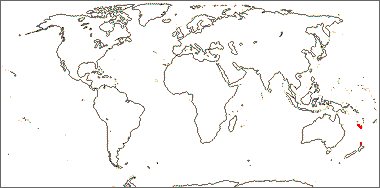Family name: Xeronemataceae M. W. Chase et al.
Synonym(s): [none]
Common name(s): xeronema family
*Number of genera/species: 1/2
List of genera records in GRIN-Global
seed
Fruit a loculicidalloculicidal:
type of capsular dehiscence, opening longitudinally through the locules (compare septicidal)
 capsulecapsule:
capsulecapsule:
a dry, dehiscent fruit derived from a compound ovary (separating only at the apexapex:
(separating only at the apexapex:
the point farthest from the point of attachment, or the "tip" of an organ ), 9-11 mm long (includes gynophoregynophore:
), 9-11 mm long (includes gynophoregynophore:
stalk-like basal portion of the ovary, bearing the main body of the pistil at its summit ), trigonoustrigonous:
), trigonoustrigonous:
3D shape—having three faces that meet at distinct angles; triangular in outline
, angledangular:
2D shape—having sides that meet at acute or obtuse angles
or tereteterete:
approximately circular in cross section; width and thickness approximately equal
 in transection, stylar remnantsstyle base:
in transection, stylar remnantsstyle base:
remnant of a style and perianthperianth:
and perianthperianth:
collective term for calyx and corolla of a flower
 persistent, with10–25 seeds. Pericarppericarp:
persistent, with10–25 seeds. Pericarppericarp:
fruit wall or fruit coat
brown, indurateindurate:
texture—hardened or stony; yielding under strong pressure; not deformable without internal structural disruption
.
Seeds ovoidovoid:
3D shape—ovate , 1.6 mm long. Seed coat black, phytomelan-encrusted, spinyspiny:
, 1.6 mm long. Seed coat black, phytomelan-encrusted, spinyspiny:
having slender, stiff, sharp projections oriented in the general plane of the structure , reticulatereticulate:
, reticulatereticulate:
surface relief—netted, raised walls or concave grooves forming a net-like surface pattern with flat, concave, or convex interspaces , or papillatepapillate:
, or papillatepapillate:
surface relief—bearing minute, distinct, broad-based projections, tapering to a rounded apex .
.
Embryo linearlinear:
(shape) long, narrow, and uniform in width; (of embryo) embryo is straight and much longer than wide , cylindriccylindrical:
, cylindriccylindrical:
3D shape—a cylinder, with parallel sides and a circular cross-section; tubular or rod-shaped
, straight.
| Fruit | |
| Type | capsulecapsule: a dry, dehiscent fruit derived from a compound ovary  |
| Size range | 9–11 mm long |
| Shape(s) | trigonoustrigonous: 3D shape—having three faces that meet at distinct angles; triangular in outline |
| Texture | indurateindurate: texture—hardened or stony; yielding under strong pressure; not deformable without internal structural disruption |
| Surface relief | unknown |
| Color(s) | brown |
| Unique features | Trigonoustrigonous: 3D shape—having three faces that meet at distinct angles; triangular in outline , indurateindurate: texture—hardened or stony; yielding under strong pressure; not deformable without internal structural disruption , loculicidalloculicidal: type of capsular dehiscence, opening longitudinally through the locules (compare septicidal)  capsulescapsule: capsulescapsule:a dry, dehiscent fruit derived from a compound ovary  with gynophores. with gynophores. |
| Seed | |
| Size range | 1.6 mm long |
| Shape(s) | ovoidovoid: 3D shape—ovate  |
| Surface relief | spinyspiny: having slender, stiff, sharp projections oriented in the general plane of the structure  , papillatepapillate: , papillatepapillate:surface relief—bearing minute, distinct, broad-based projections, tapering to a rounded apex  , reticulatereticulate: , reticulatereticulate:surface relief—netted, raised walls or concave grooves forming a net-like surface pattern with flat, concave, or convex interspaces  |
| Color(s) | black |
| Unique features | Phytomelan-encrusted, black, spinyspiny: having slender, stiff, sharp projections oriented in the general plane of the structure  , papillatepapillate: , papillatepapillate:surface relief—bearing minute, distinct, broad-based projections, tapering to a rounded apex  , or reticulatereticulate: , or reticulatereticulate:surface relief—netted, raised walls or concave grooves forming a net-like surface pattern with flat, concave, or convex interspaces  seeds. seeds. |
| Other | |
| Embryo | linearlinear: (shape) long, narrow, and uniform in width; (of embryo) embryo is straight and much longer than wide  , cylindriccylindrical: , cylindriccylindrical:3D shape—a cylinder, with parallel sides and a circular cross-section; tubular or rod-shaped , straight |
New Caledonia, New Zealand.

Distribution map courtesy of Angiosperm Phylogeny Website.
Baskin and Baskin 2021Baskin and Baskin 2021:
Baskin C and Baskin J. 2021. Relationship of the lateral embryo (in grasses) to other monocot embryos: A status up-grade. Seed Science Research 31 (3): 199-210. doi:10.1017/S0960258521000209; Dahlgren et al. 1985Dahlgren et al. 1985:
Dahlgren RMT, Clifford HT, and Yeo PF. 1985. The families of the monocotyledons: structure, evolution, and taxonomy. Springer-Verlag, Berlin. 520 pp.; Kirkbride et al. 2006Kirkbride et al. 2006:
Kirkbride JH, Jr, Gunn CR, and Dallwitz MJ. 2006. Family guide for fruits and seeds, vers. 1.0. Accessed September 2020-January 2022. URL: https://nt.ars-grin.gov/seedsfruits/keys/frsdfam/index.cfm .; Kubitzki et al. 1990+Kubitzki et al. 1990+:
Kubitzki K et al., eds. 1990+. The families and genera of vascular plants. 7+ vols. Berlin etc.
*The number of genera and species is based on Christenhusz and Byng 2016Christenhusz and Byng 2016:
Christenhusz MJM and Byng JW. 2016. The number of known plant species in the world and its annual increase. Phytotaxa 261 (3): 201-217. https://doi.org/10.11646/phytotaxa.261.3.1, which may differ from the number of genera in GRIN-Global.